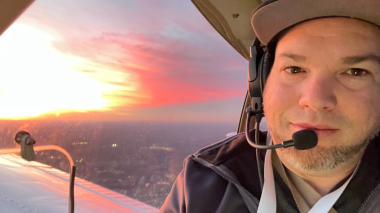Golf is known for being a mental game. But it can also put stress on your muscles, joints and tendons. You use your entire body to forcefully swing a club behind you and back through to hit the ball as powerfully – and accurately – as possible.
That “back-and-through” movement is what many people spend decades trying to perfect, but the repetitive motion can also cause serious injuries.
The team of orthopedic and sports medicine specialists at Atrium Health Musculoskeletal Institute and Atrium Health Carolinas Rehabilitation work with patients who experience pain due to overusing specific muscles while golfing, as well as golfers who suffer unrelated injuries that are made worse by the sport’s repetitive motions.
Dr. Eric Warren specializes in primary care sports medicine at the Atrium Health Musculoskeletal Institute and is the medical director of athletics for Wingate University and team physician for the Charlotte Knights. Warren says golf-related injuries are common but can often be prevented.
“So much of what we see associated with golf-related pain and injury can be prevented with core strengthening and flexibility work, which must happen before you’re ever on the course,” says Warren. “Once on the course and before playing, a good dynamic warm up will help increase blood flow to the muscles and joints, and then hydrating while you play will help muscle repair what happens in real time.”
Common Golf Injuries
Robert McDowell, physical therapist with Atrium Health Carolinas Rehabilitation, says lower back pain (LBP) is the primary complaint of golfers in the U.S.
“LBP represents 36% of amateur and 63% of pro golfers who report golf-related symptoms,” says McDowell. “A strong swing can be crucial to your game, but it can also be devastating to your lower back.”
McDowell says the force that occurs during a golf swing contributes to LBP and can lead to the potential for more severe injuries down the road.
While LBP is the most common golf-related injury, Shubhra Tyagi, team lead physical therapist at Atrium Health Carolinas Rehabilitation, says it is not uncommon for golfers to also experience pain in the elbows, wrists, rotator cuffs and knees.
“It can be a kinetic chain,” says Tyagi. “If one part of the body is not doing its job, the other pieces start overcompensating to help out.”
Warren says he frequently sees patients with golfer’s elbow and tennis elbow (or medial and lateral epicondylitis, respectively) due to the repetitive motion and force golf entails, as well as long-term effects to the joints.
“As golfers age, the painful effects of knee arthritis frequently impede the ability to enjoy walking the course and sometimes even just swinging the club,” says Warren. “The Atrium Health Musculoskeletal Institute is well equipped to handle all of these issues.”
Tips to Avoid Golf Injuries
Modify your Swing
McDowell explains the difference in hip and torso rotation in the modern versus the classic golf swing – with the modern swing being more demanding on the body than the classic swing.
“The modern swing requires a curve in the spine and ends the follow-through with the spine extended in a reverse ‘c’ curve,” explains McDowell. “In the classic swing, the hips and shoulders are parallel, which means less rotation of the torso and less stress and force on the lower back. If you finish your swing with upright posture in your follow-through, it can take compressive forces off your back.”
 |
 |
|
McDowell says you can also try these modifications to your swing:
Like when you run or workout, you can lessen the risk of injury by warming up the muscles you’re going to use. |
For golf, McDowell says general flexibility exercises and a 10-minute dynamic warmup can reduce the incidence of lower back pain by up to 60%. A strong core is also crucial to stabilizing your body when you engage in a powerful swing rotation. So exercises that work on range of motion and target core strength are especially helpful for golfers.
“If you don’t have hip flexibility and mobility, you will need to get your rotation from somewhere else – likely from your spine,” says McDowell. “That’s where overcompensation and injury can come into play.”
McDowell recommends incorporating these moves as an 8-week exercise program to improve core stability to increase flexibility and strengthen your core:
- Side planks: Rest your right forearm on the ground directly under your shoulder. Extend your legs out to your side, stacking them on top of each other from hips to feet. Make sure your head stays in line with your spine. Hold for 30 seconds, then turn over and repeat on the left side.
- Low plank with a leg lift: Start in a low plank position, with both forearms on the floor shoulder-width apart. Engage your abs while keeping your shoulders, hips and ankles in a line (careful not to drop your hips or curve your back). Lift one leg straight up until it’s about hip-level, keeping your foot flexed and pausing at the top of the lift before lowering back down. Alternate this movement several times on each leg.
- Bird-dog stretches: Start with your hands and knees on the ground and your spine in a neutral position. Extend your opposite arm and leg out until they are parallel to the floor. Hold for a count of six, then place your arm and leg back down and repeat on the other side.
- Glute bridges: Lie on your back with your knees bent about hip-width apart and feet flat on the ground. Keep your arms at your side and your palms flat on the ground. Lift your hips off the ground, engaging your glutes and your abdominal muscles, until your knees, hips and shoulders are in line. Hold for a few seconds and lower back down. Repeat for three rounds of 10 reps.
- Sit-ups: Lie on your back with your knees bent and feet planted firmly on the ground. Place your hands gently behind your head on either side of your ears, without pulling on your neck. Keep your chin slightly lifted and slowly curl your upper body toward your knees, exhaling as you sit up. Slowly lower your upper body back to the ground, inhaling as you return to your starting position. Repeat for three rounds of 10 reps.
In addition, McDowell suggests practicing both right and left-handed swings for improved flexibility and coordination.
Work with a Pro
If you have experienced an injury that is impacting your golf game, you may want to consider working with a health care provider who specializes in sports medicine.
An orthopedic or sports medicine specialist may start by asking you about your history of injuries, and then work with you to design a plan based on the location of the pain and your own personal goals – like how to return to the sport after recovering from surgery.
“I stress to golfers that when pain or injuries arise, we will get them better,” says Warren. “Golf, more than any other sport, is a game of recovery, not perfection. That’s true on the course with a bad shot, and it’s true when injuries arise, as well.”
Knowledge is an important part of the process – not just to treat it, but also to understand why the pain is there. That’s why it’s helpful for physical therapists to know previous injuries that may be contributing to the problem.
“Maybe it’s a knee surgery and the patient didn’t get full range of motion back. Or a back surgery that didn’t heal properly. But once we identify those deficits, we can work through how that may be contributing to your recovery,” says Tyagi.
Your customized treatment plan can include working with a specialized physical therapist to strengthen your muscles for a safer swing. You will also learn a series of movements you can do at home to increase flexibility and prevent injury.
“We’re here to help, but we also want to empower you with knowledge to recognize what’s wrong and know how to manage it,” says Tyagi. “That can lessen the risk of more severe injuries down the road.”
Atrium Health Musculoskeletal Institute provides a full spectrum of surgical and nonsurgical care for conditions affecting your bones, muscles, joints and other connective tissue. Our team of sports medicine experts include doctors, physical therapists and occupational therapists who work together to deliver tailored treatments for fuller recoveries.
“Our goal is to provide the best support to those who need help returning to the sport they love,” says Tyagi.
Learn more about the customized treatment options offered at Atrium Health Carolinas Rehabilitation, named a Best Rehabilitation Hospital by U.S. News & World Report.



